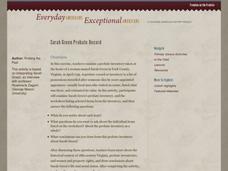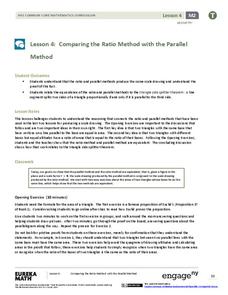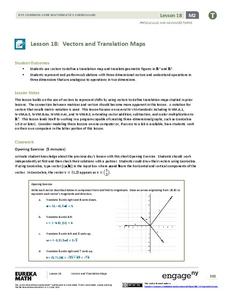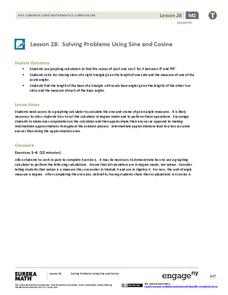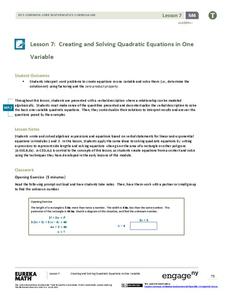Curated OER
Bud, Not Buddy: Guided Imagery Exercise
Develop readers’ awareness of the visual power of language with a guided imagery exercise. Set the stage and create the mood with dim lights, soft music and potpourri. Then read the provided section of Bud, Not Buddy. Next, invite...
Curated OER
Much Ado About Nothing: Guided Imagery Exercise
“Be glad that all things sort so well.” To make text-to-self connections to Shakespeare’s play, class members engage in a guided imagery exercise prior to reading Act IV, scene i of Much Ado About Nothing (the wedding of Claudio and...
Novelinks
The Cure: Guided Imagery
Prepare class members for a discussion of Sonia Levitin's dystopian novel The Cure, by leading them on a guided imagery exercise designed to encourage visualization of written descriptions.
Curated OER
Tangerine: Instructions for Guided Imagery
A guided imagery exercise draws class members into a particularly intense scene in Edward Bloor's Tangerine. After listening to a reading of an excerpt from the text, participants respond to a series of questions and then share their...
Novelinks
The Dark Is Rising: Guided Imagery
To launch a reading of The Dark is Rising, the second novel in Susan Cooper's award winning contemporary fantasy novel sequence for young adults, class members engage in a guided imagery exercise that asks them to visualize the setting...
Curated OER
Guided Imagery: Canyons, Chapter 8
Individuals use words or illustrate what they experience during a reading of a passage from chapter eight of Gary Paulsen's Canyons. Complete directions for the guided imagery exercise, and a suggested passage, are included with the...
EngageNY
Making Scale Drawings Using the Parallel Method
How many ways can you create a dilation? Many! Individuals strengthen their understanding of dilations by using various methods to create them. The new technique builds on pupils' understanding of the ratio method. Using the ratio,...
Roy Rosenzweig Center for History and New Media
The Boston Massacre: You Be the Judge!
The importance of considering multiple perspectives of the same event is the big idea in this exercise that focuses on the Boston Massacre. Class groups examine photos of four depictions of the massacre, an English and an American...
Curated OER
Guided Reading Organizer for Chain Reaction
The class uses Chain Reaction, a magazine, to build a better understanding of Latin and Greek roots found in scientific vocabulary. They use two attached worksheets to help them read a scientific article, using visual clues and their...
Novelinks
Running Out of Time: Anticipation Guide
Get your class ready to read with this anticipatory set for Running Out of Time. Small groups each consider one thought-provoking statement. After each group comes to a consensus, the whole class participates in sharing ideas and voting...
EngageNY
Grade 9 ELA Module 3, Unit 3, Lesson 7
As the unit on research writing draws to a close, class members continue to revise and edit their papers, this time focusing on grammar, spelling, and punctuation (colon and semicolon).
Teach with Movies
Teaching Students to Write a Narrative
Encourage narrative writing with a clever exercise. Class members watch episodes from movies and describe what happened to a character, including details about the setting, plot, and characters. Writers then craft a narrative about a...
Curated OER
Thematic Maps of Your School
Students are able to list the essential elements of a thematic map, understand and use scale effectively to represent a geographic area, use research skills to develop a body of information, plan and draw an accurate thematic map based...
EngageNY
Construct an Equilateral Triangle (part 1)
Drawing circles isn't the only thing compasses are good for. In this first installment of a 36-part series, high schoolers learn how to draw equilateral triangles by investigating real-world situations, such as finding the location of a...
Roy Rosenzweig Center for History and New Media
Sarah Green Probate Record
The proof is in the probate record. Much can be learned about history by investigating old, primary source documents. Class members hone their detective skills by examing the 1759 probate record of Sarah Green. Who was this lady? Was she...
EngageNY
Using Linear Models in a Data Context
Practice using linear models to answer a question of interest. The 12th installment of a 16-part module combines many of the skills from previous lessons. It has scholars draw scatter plots and trend lines, develop linear models, and...
Center for the Advancement of Ethics and Character
Charlotte's Web: A Story About Friendship
Strengthen the bonds of friendship within your class with a reading of E.B. White's award-winning novel, Charlotte's Web. Focusing on the unique characters in the story and the relationships they develop, young readers draw from their...
EngageNY
Comparing the Ratio Method with the Parallel Method
Can you prove it? Lead your class through the development of the Side Splitter Theorem through proofs. Individuals connect the ratio and parallel method of dilation through an exploration of two proofs. After completing the proofs,...
Curated OER
Rosencrantz and Guildenstern Are Dead: DR-TA Strategy
Making predictions is an excellent reading strategy. Work on building this into your pupils' toolkit of strategies by trying out the process outlined here for reading the very beginning of Rosencrantz and Guildenstern Are Dead. The...
Curated OER
Maus Lesson Plan
The artistic choices Art Spiegelman made in his graphic novel, Maus, are the focus of an exercise that asks class members to compare classic comic book forms with Spiegelman’s panels and frames. Directed to specific pages and guided by a...
EngageNY
Vectors and Translation Maps
Discover the connection between vectors and translations. Through the lesson, learners see the strong relationship between vectors, matrices, and translations. Their inquiries begin in the two-dimensional plane and then progress to the...
EngageNY
Solving Problems Using Sine and Cosine
Concepts are only valuable if they are applicable. An informative resource uses concepts developed in lessons 26 and 27 in a 36-part series. Scholars write equations and solve for missing side lengths for given right triangles. When...
EngageNY
Finding Systems of Inequalities That Describe Triangular and Rectangular Regions
How do you build a polygon from an inequality? An engaging lesson challenges pupils to do just that. Building from the previous lesson in this series, learners write systems of inequalities to model rectangles, triangles, and even...
EngageNY
Creating and Solving Quadratic Equations in One Variable
Give your classes practice at modeling using quadratic models with a resource that uses area and integer problems to allow individuals to create second degree polynomials. Young mathematicians solve equations using factoring and then...
















